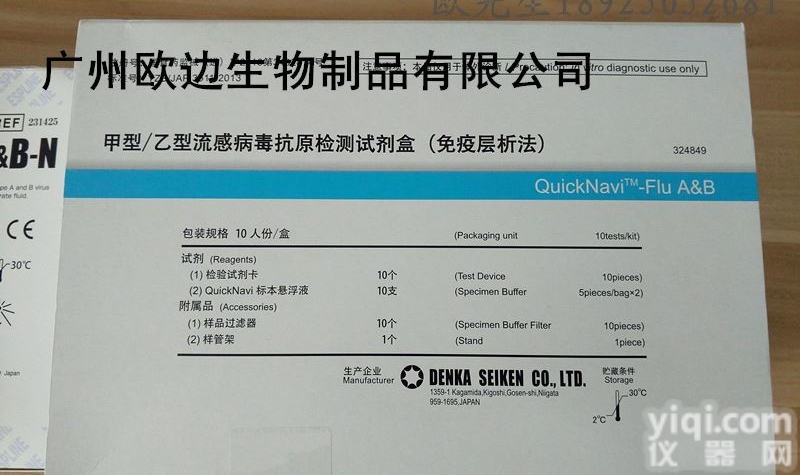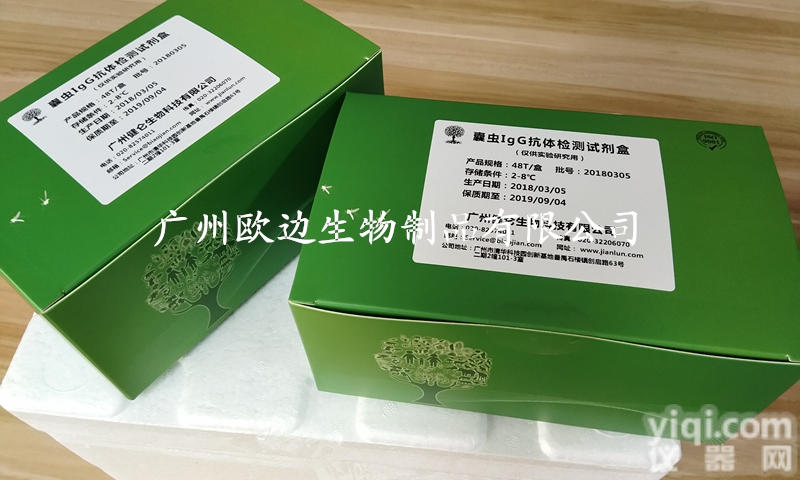公筷易感染腮腺炎病毒IgG elisa检测试剂盒
广州健仑生物科技有限公司
广州健仑长期供应各种PCR试剂盒,主要代理进口和国产品Pai的流行病毒PCR检测试剂盒。例如:甲乙型流感病毒核酸检测试剂盒、黄热病毒核酸检测试剂盒、诺如病毒核酸检测试剂盒、登革病毒核酸检测试剂盒、基孔肯雅病毒核酸检测试剂盒、结核杆菌核酸病毒检测试剂盒、孢疹病毒核算检测试剂盒、西尼罗河病毒PCR检测试剂盒、呼吸道合胞病毒核酸检测试剂盒、冠状病毒PCR检测试剂盒等等。虫媒体染病系列、呼吸道病原体系列、发热伴出疹系列、消化道及食源感染系列。
产品规格:96T/盒
存储条件:4-8℃
我司同时还提供、美国FOCUS、西班牙DIA、美国trinity等知名品Pai试剂盒:
麻疹、风疹、甲流 、乙流、单疱疹1型、单疱疹2型、百日咳、百日咳毒素、腮腺炎、带状疱疹、单纯疱疹、HSV1型特异性、巨细胞-特异、风疹-特异、弓形虫-特异、棘球属、嗜肺军团菌、破伤风、蜱传脑炎、幽门螺旋杆菌、白色念珠菌、博氏疏螺旋体、细小病毒、钩端螺旋体、腺病毒、Q热柯克斯体、烟曲霉菌、埃可病毒、EB病毒、衣原体、耶尔森菌、空肠弯曲杆菌、炭疽杆菌、白喉、肠道病毒、柯萨奇病毒、肺炎衣原体、沙眼衣原体、土拉弗朗西斯菌、汉坦病毒、类风湿因子、呼吸道合胞病毒、单纯疱疹病毒质控品、巨细胞质控品、弓形虫质控品、风疹麻疹质控品、等试剂盒以。
欢迎咨询
欢迎咨询
公筷易感染腮腺炎病毒IgG elisa检测试剂盒
我司还提供其它进口或国产试剂盒:登革热、疟疾、流感、A链球菌、合胞病毒、腮病毒、乙脑、寨卡、黄热病、基孔肯雅热、克锥虫病、违禁品滥用、肺炎球菌、军团菌、化妆品检测、食品安全检测等试剂盒以及日本生研细菌分型诊断血清、德国SiFin诊断血清、丹麦SSI诊断血清等产品。
欢迎咨询 欧
欢迎咨询

想了解更多的产品及服务请扫描下方二维码:

【公司名称】 广州健仑生物科技有限公司
【市场部】 欧
【】
【腾讯 】
【公司地址】 广州清华科技园创新基地番禺石楼镇创启路63号二期2幢101-103室

蓝球藻,念珠藻,颤藻,发菜(细胞群体呈黑蓝细菌)均属于蓝藻,所以蓝藻并不都是呈现绿细菌的。
支原体(mycoplasma)的大小通常为0.2-0.3微米,是现认为Z小的细胞,可通过滤菌器。无细胞壁,
不能维持固定的形态而呈现多形性。细胞膜中胆固醇含量较多,约占36%,这对保持细胞膜的完整性是必需的,凡能作用于胆固醇的物质(如二性霉素B、皂素等)均可引起支原体膜的破坏而使支原体死亡。
支原体基因组为一环状双链DNA,分子量小(仅有大肠杆菌的五分之一),合成与代谢很有限。肺炎支原体的一端有一种特殊的末端结构(terminal structure),能使支原体粘附于呼吸道粘膜上皮细胞表面,与致病性有关。衣原体(Chlamydia)很小,直径200-500纳米,能通过细菌滤膜。立克次氏体(Rickettsia)略大,大多不能通过滤菌膜。它们都有DNA和RNA,有革兰氏阴性细菌特征的含肽聚糖的细胞壁,但酶系统不完全,必须在寄主细胞内生活,有摄能寄生物(energe parasite)之称。
砂眼是衣原体引起的,由于能形成包含体,起初被认为是大型病毒,1956年,ZG微生物学家汤飞凡及其助手张晓楼等人首次分离到沙眼的病原体。
衣原体生活史特殊,具有感染力的个体称为原体(elementory body),体积小,有坚韧的细胞壁。在宿主细胞内,原体逐渐伸长,形成无感染力的个体,称作始体(initial body),是一种薄壁的球状细胞,体积较大,通过二等分裂的方式在宿主细胞内形成一个微菌落,随后大量的子细胞有分化为具有感染能力的原体。
立克次氏体也是专性细胞内寄生的,主要寄生于节肢动物,有的会通过蚤、虱、蜱、螨传入人体、如斑疹伤寒、战壕热。
美国医生H.T.Richetts 1909年首次发现它是落基山斑疹伤寒的病原体,并于1910年牺牲于此病,故后人称这类病原体为立克次氏体。与衣原体的不同处在于其细胞较大,无滤过性,合成能力较强,且不形成包涵体。
Blue algae, nostalgia, algae, algae, hair cells (cell populations were black and blue bacteria) belong to cyanobacteria, cyanobacteria are not all present green bacteria.
Mycoplasma, typically 0.2-0.3 microns in size, is the smallest known cell that can pass through a bacteria filter. No cell wall,
Can not maintain a fixed form and showing pleomorphism. Cholesterol content in the cell membrane more, accounting for about 36%, which is necessary to maintain the integrity of the cell membrane, where can act on cholesterol substances (such as amphotericin B, saponin, etc.) can cause mycoplasma membrane damage and Mycoplasma death.
Mycoplasma genome is a circular double-stranded DNA, small molecular weight (only one fifth of E. coli), synthesis and metabolism is limited. Mycoplasma pneumoniae at one end has a special terminal structure (terminal structure), can make Mycoplasma adhesion to the surface of respiratory epithelial cells, and pathogenicity. Chlamydia is very small, 200-500 nm in diameter, and can pass through bacterial filters. Rickettsia is slightly larger and mostly can not pass through the filter membrane. They all have DNA and RNA, and have peptidoglycan-containing cell walls characterized by Gram-negative bacteria. However, the enzyme system is incomplete and must live in the host cell with the name energe parasite.
Trachoma is caused by Chlamydia. Due to its formation of inclusion bodies, it was initially considered as a large virus. In 1956, the famous Chinese microbiologist Tang Feifan and his assistant Zhang Xiaolou were the first to isolate the pathogen of trachoma.
Chlamydia special life history, infectious individuals known as the body (elementory body), small, tough cell walls. In host cells, protoplasts progressively expand to form non-infectious individuals, called initial bodies, which are thin-walled globular cells that are bulky and divide within the host cell by a second division Form a micro-colony, then a large number of daughter cells have the ability to differentiate into the original body.
Rickettsia is also a specialized intracellular parasitism, mainly parasitic on arthropods, some through fleas, lice, ticks, mites into the body, such as typhus, trencher fever.
American physician H.T. Richetts first discovered in 1909 that it was the causative agent of the typhus in Rocky Mountain and died of the disease in 1910. Therefore, it is later described as rickettsia. Chlamydia and the difference lies in its larger cells, no filtration, synthesis ability, and does not form inclusion bodies.
 美国trinity 公筷易感染腮腺炎病毒IgG elisa检测试剂盒
美国trinity 公筷易感染腮腺炎病毒IgG elisa检测试剂盒
 Elisa试剂盒之人腮腺炎病毒IgM Elisa试剂盒
Elisa试剂盒之人腮腺炎病毒IgM Elisa试剂盒
 Elisa试剂盒之人腮腺炎病毒IgG Elisa试剂盒
Elisa试剂盒之人腮腺炎病毒IgG Elisa试剂盒
 腮腺炎病毒检测试剂盒,腮腺炎病毒IGg试剂盒,腮腺炎病毒IgM试剂盒,腮腺病毒ELISA检测试剂盒
腮腺炎病毒检测试剂盒,腮腺炎病毒IGg试剂盒,腮腺炎病毒IgM试剂盒,腮腺病毒ELISA检测试剂盒
 腮腺炎病毒检测试剂盒,腮腺炎病毒IGg试剂盒,腮腺炎病毒IGg试剂盒
腮腺炎病毒检测试剂盒,腮腺炎病毒IGg试剂盒,腮腺炎病毒IGg试剂盒
 腮腺炎病毒检测试剂盒,腮腺炎病毒IGg试剂盒,腮腺炎病毒IgM试剂盒
腮腺炎病毒检测试剂盒,腮腺炎病毒IGg试剂盒,腮腺炎病毒IgM试剂盒
 麻疹病毒、风疹病毒、腮腺炎病毒三重核酸荧光PCR检测试剂盒,麻疹病毒、风疹病毒、腮腺炎病毒三重核酸荧光PCR检测试剂盒说明书,麻疹病毒、风疹病毒、腮腺炎病毒三重核酸检测试剂
麻疹病毒、风疹病毒、腮腺炎病毒三重核酸荧光PCR检测试剂盒,麻疹病毒、风疹病毒、腮腺炎病毒三重核酸荧光PCR检测试剂盒说明书,麻疹病毒、风疹病毒、腮腺炎病毒三重核酸检测试剂
 诊断试剂盒 美国focus飞沫传播腮腺炎病毒检测试剂盒
诊断试剂盒 美国focus飞沫传播腮腺炎病毒检测试剂盒
 检测试剂盒 美国FOCUS冬季易感染腮腺炎病毒诊断试剂
检测试剂盒 美国FOCUS冬季易感染腮腺炎病毒诊断试剂
 人流行性腮腺炎(EP)ELISA 试剂盒 人流行性腮腺炎(EP)ELISA 试剂盒供应商
人流行性腮腺炎(EP)ELISA 试剂盒 人流行性腮腺炎(EP)ELISA 试剂盒供应商
 人腮腺炎病毒IgM ELISA 试剂盒 人腮腺炎病毒IgM ELISA 试剂盒供应商
人腮腺炎病毒IgM ELISA 试剂盒 人腮腺炎病毒IgM ELISA 试剂盒供应商
 人腮腺炎病毒IgG ELISA 试剂盒 人腮腺炎病毒IgG ELISA 试剂盒供应商
人腮腺炎病毒IgG ELISA 试剂盒 人腮腺炎病毒IgG ELISA 试剂盒供应商